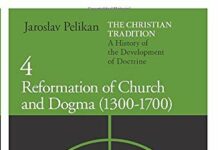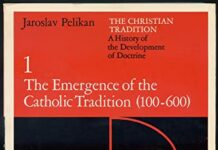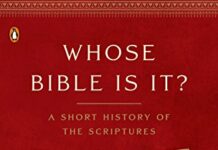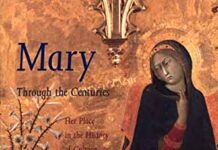
Ebook Info
- Published: 1980
- Number of pages: 364 pages
- Format: PDF
- File Size: 4.28 MB
- Authors: Jaroslav Pelikan
Description
“A magnificent history of doctrine.”—New York Review of Books”In this volume Jaroslav Pelikan continues the splendid work he has done thus far in his projected five-volume history of the development of Christian doctrine, defined as ‘what the Church believes, teaches, and confesses on the basis of the word of God.’ The entire work will become an indispensable resource not only for the history of doctrine but also for its reformulation today. Copious documentation in the margins and careful indexing add to its immense usefulness.”—E. Glenn Hinson, Christian Century”This book is based on a most meticulous examination of medieval authorities and the growth of medieval theology is essentially told in their own words. What is more important, however, then the astounding number of primary sources the author has consulted or his sovereign familiarity with modern studies on his subject, is his ability to discern form and direction in the bewildering growth of medieval Christian doctrine, and, by thoughtful emphasis and selection, to show the pattern of that development in a lucid and persuasive narrative. No one interested in the history of Christianity or theology and no medievalist, whatever the field of specialization, will be able to ignore this magnificent synthesis.”—Bernhard W. Scholz, History”The series is obviously the indispensable text for graduate theological study in the development of doctrine, and an important reference for scholars of religious and intellectual history as well. . . . Professor Pelikan’s series marks a significant departure, and in him we have at last a master teacher.”—Marjorie O’Rourke Boyle, Commonweal
User’s Reviews
Editorial Reviews: From the Back Cover This book is based on a most meticulous examination of medieval authorities and the growth of medieval theology is essentially told in their own words. What is more important, however, than the astounding number of primary sources the author has consulted or his sovereign familiarity with modern studies on his subject, is his ability to discern form and direction in the bewildering growth of medieval Christian doctrine and, by thoughtful emphasis and selection, to show the pattern of that development in a lucid and persuasive narrative. About the Author Jaroslav Pelikan (1923-2006) was Sterling Professor of History Emeritus at Yale University.
Reviews from Amazon users which were colected at the time this book was published on the website:
⭐This is the third of five volumes of the late Jaroslav Pelikanâ(tm)s classic series on the historical development of Christian doctrine. Combining the highest degree of historical scholarship with the pedagogical skill of a great teacher, Pelikanâ(tm)s work still stands as the standard source when approaching the question of doctrinal origins.In this volume, Pelian explores the development of doctrine in Western Christendom from the close of the patristic era to the height of medieval scholasticism. In this period, the Western Church, beginning with the theological synthesis of St. Augustine of Hippo, developed an outlook on the Christian faith that differed in fundamental ways with theological currents in the Christian East. The collapse of the Western Roman Empire, the use of Latin instead of Greek, and the increasing claims of the papacy all were hallmarks on this era where the Christian West began to assert its own unique theology.Pelikan begins with the book with an historical exposition of the Augustinian synthesis and its understanding of the Catholic tradition. The Western Church no less than the East claimed loyalty to the tradition of the Fathers but saw it though an Augustinian prism. So pervasive was the influence of the great Bishop of Hippo, that it seemed natural to add the clause “and the Son” to the Creed when speaking of the Holy Spirit simply based on St. Augustine’s own writings on the Trinity. Not just on the Trinity, but on every key aspect of the faith, St. Augustine of Hippo was a towering figure. His ideas on salvation, the nature of the Church, and the Sacraments would dominate Western thinking for centuries to come and the earlier Fathers would be interpreted through the synthesis he created.Then turning to the period at the end of the patristic era, Pelikan explores how Western theologians began to extend the Augustinian synthesis in the face of new challenges. Among the theological challenges facing Western Christendom were semi-adoptionst views, the blurring of the line between the doctrine of the Trinity and tritheism, the role of faith and works in salvation, the nature of the Sacraments, and the position of Mary in the divine economy.Some of these issues, as Pelikan skillfully details, would continue to occupy the theological concerns of the Western Church for centuries to come. One of the areas where such concerns would meld to form a more comprehensive view occurred as the Western Church began to develop its theology of the divine economy. Within Western theology, salvation had since St. Augustine emphasized tended towards a transactional theory of atonement which differed from the idea of theosis that was holding sway in the East. However, the exact nature of the transaction involved was left nebulous in the writings of the great bishop of Hippo.An idea that had begun to hold sway in the Western Church was the ransom theory whereby Jesus gave His life as a ransom paid to Satan who was then unable to hold him in the bondage of death. New speculation began in the eleventh century with St. Anselm who asserted instead that no ranson is owed to Satan but instead satisfaction to God’s honor. Although St. Anselm’s theories met some opposition (notably Peter Abelard who backed a theory of Jesus redeeming us by His moral example), the idea would eventually begin to dominate Western thinking and be held as the logical consequence of Augustinian theology.Pelikan focuses in on St. Anselm’s satisfaction theory of the atonement as setting the stage for all discussion on the matter in the Western Church for centuries to come. The theory would continue to be developed in various ways but Western ideas on salvation became uniformly cross-centered. The cross was the turning point in human history and the fact that the crucifixion had been for the salvation of mankind demonstrated that Christ was the Lord of history and His sovereignty was absolute.Pelikan then turns to the matter of how the grace won by Christ was made efficacious for men. Here special attention is focused on two developments within Western Christianity: the role of the Communion of Saints – especially the Virgin Mary – in the divine economy and the role of the Sacraments in communicating grace to us. Although the core was something imported from the Church’s earlier Catholic tradition, the Western Church would further develop the particulars into a distinctive theological consensus.In examining the issue of devotion to Mary and the Saints, Pelikan notes that such practices had long been established, but the West began to develop them in new directions. What began to set apart the Western understanding of Mary’s role in the divine economy was the emphasis placed on her as mediatrix. This was not to be understood as mediating in the sense of Christ who mediates between God and man through His sacrifice on the cross, but in the sense that she brought Christ to us through the Incarnation and can bring us to Christ through her intercession. Still, it was subject to excesses and this new attention paid to Mary would lead to the elevation of devotion to saints in general as the excesses of popular piety became a seriously debated issue in the Church.Pelikan then explores how debates over the exact nature of the Eucharist led to the evolution of the theory of transubstantiation within the Western Church. Theological arguments over the nature of Christ’s presence, whether the presence was objective or subject to the believer’s faith, and other related issues all led to the adoption of the language of substance and accidents in the presentation of the emerging doctrine. The concerns over the Eucharist opened up the discussion for the nature of the Sacraments in general. These disputes included the definition of what constituted a Sacrament and the numbering of the Sacraments. As time went on, a general agreement of a Sacrament as an outward sign conferring an inward grace and the numbering of seven (Baptism, Eucharist, Confirmation, Penance, Ordination, Matrimony, Exreme Unction) would be the consensus.Pelikan then describes how the Western Church, with its development of doctrine and ecclesial polity, would more and more see itself as upholding the one true faith of Christ in a fallen world. The patristic consensus of earlier centuries was viewed entirely through the prism of Augustinian theology and even this Augustinian view was interpreted through the later developments of St. Anselm and others. Thus later developments within the Western Church (known as the Catholic Church) were projected onto the patristic writers and the interpretations of the Eastern Church (known as the Orthodox Church) were viewed as deviations even though the latter were often closer to the original intent of the Church fathers themselves. The truth of the developed Catholic consensus was challenged not only by the Eastern Church but by various spliter groups that developed in the West to protest the corruption of power and worldliness within the Catholic Church and also the rise of the dualist Cathari. Responses to such challenges often were to deem them as heretical on the basis of their challenging the papal authority. Even the Eastern Churches, which stayed faithful to the original version of the Creed delivered by the Councils of Nicea and Constantinople, were deemed as at fault for not changing the Creed to include the fillioque added centuries later by the Western Church.Pelikan also delves into the relationship between Catholicism and non-Christian religions. There was renewed contact with Judaism in this period that reached far beyond the triumphalism of earlier centuries. Much of this contact was frequently between Jews and Jewish converts to Catholicism. There were still, however, limits to how far this dialogue could proceed and some in the Church were always wary of a “Judaizing” tendency among Catholic so engaged. The rise of Islam as a world power also necessitated a response and here Western theologians joined their Eastern counterparts in seeing it as a Christian heresy that mixed truths of the Catholic faith with errors accumulated elsewhere.Perhaps the greatest challenge to the Catholic Church was the recovery of the works of Aristotle. The East had long been familiar with the philosopher and even Islam had its take on his work, but the recovery of his philosophy shook the intellectual community within the Catholic Church to its foundations. Here was a perfectly integrated worldview – perhaps the most sophisticated yet devised – that was completely without Catholic influence. Pelikan explores how theologians grappled with this new synthesis while trying to maintain the brand of Augustinian theology that had become the standard for Catholic theological discussion.The greatest example of this was the new synthesis achieved by St. Thomas Aquinas in the Summa Theologica. Aquinas’ towering achievement left in tact the Catholic docrine by stripping it of much of the platonic influence in the Augustinian synthesis and expressing it in terms of the Aristotelian view. The essential Augustiniansim of the system was maintained but its new outlook more clearly integrated it with the study of nature. The new syntheses led to further theolgical development as new areas of intellectual investigation opened up but the new approach was not without its critics. The often slavish reliance on Aristotle by less talented interpreters than the great scholastics of the thirteenth century would eventuall ossify much of Catholic theology and lead to the undoing of much of its achievements.The development of Catholic doctrine in the medieval period is remarkable as it was derived from the Catholic tradition of earlier centuries but in many ways is totally different. Unlike the East, the Western Church was not hesitant about taking theology in new directions in response to internal and external influences. Jaroslav Pelikan’s account in The Growth of Medieval Theology (600-1300) makes clear how the Western Church could change elements of its faith and practice in sometimes significant ways while, in its eyes, truthfully claim to maintain the tradition as had been handed on to them. For anyone interested in how the patristic Catholic consensus developed into the medieval Catholic consensus, there is no more detailed explanation than in this book.
⭐This series is right among the top works on the history of the church and the faith. All Christians, and for that matter, all religious people would benefit from reading the entire set. The writing is clear, and well referenced, as is true for all Jaroslav Pelikan works. The series allows those curious about the history of the Christian faith understand better the origins of various approaches to the faith, and expands upon what most Christians acquire as basic information through going to church and Sunday School. Not to worry about boredom either. A real bonus for the fact-checkers and those curious as to supporting material, is that references are given on the page where the supporting material is discussed.Christianity is an exciting religion, and understanding the faith can be greatly enhanced through reading any of these wonderful texts. This volume in particular enhances understanding of what preceded the Reformation, and increases the comprehension of that vast but largely unknown period of Medieval Church. One can only benefit by understanding doctrine from this period, and greater benefit might be felt by Orthodox Christians or those considering converting to this branch of Christianity.
⭐Jaroslav Pelikan, once again, provides readers with a thorough, pluralistic view of the major theological thoughts and innovations of the period. The work, which thankfully does not ignore the Eastern church and therefore gives a truly comprehensive picture, is based on quotations from major theologians, and neither is speculative nor dilutes the writings by trying to fit them into a modern mold.This book is a superb reference for students of theology and history, and definitely “fills in the blanks” for anyone with a limited view of medieval theology. Pelikan’s writing is surprisingly readable, though it is sometimes cumbersome to have to keep checking the “marginalia” and separate listing of sources to ascertain who wrote what. It is purely a scholarly work, and not likely to please those looking for engaging narratives, but is invaluable for those with a serious interest in the subjects.
⭐I bought this book for one of my Masters Degree Classes. I’m working on a degree in Sacred Theology. Although the text book was required; I have found it to be a wealth of information on the early history of the Christian Church. I strongly recommend it.
⭐Pelikan does his usual masterful work in this volume 3 as he did in the first two volumes. This book covers about 700 years (600 – 1300). What about the men who lived during these times – Pelkan set the fact forth in a clear concise way. EG
⭐Great history of the church
⭐I learned alot from the first three volumes of this series. Great scholarship and worth reading to get an understanding of church history up to the time just preceding the reformation.
⭐What can one say about this departed giant among Christian historians and theologians than will his like grace us ever again.
⭐Jan Pelikan starts his book by describing the method used by early medieval theologists: writing about Christian doctrine by mostly quoting ancient fathers. As he notes, this does not mean uninsightfulness, and he demonstrates the fact by using the style himself. Pelikan’s book consists largely of summarising the medieval theologians, often with quotations, with only an occasional reference to modern (i.e mid-20th century, this book was published in 1978.) research. Yet, Pelikan masters his content and the style is free-flowing, and easy to follow. The reader would benefit greatly if the original Latin and Greek quotes were given, as now the reader needs to check the original references to know the original phrasing. However, the huge wealth of references allows the reader a possibility to dive deep into the original authors.Another important point is the fact that Pelikan chose deliberately not to discuss contemporary history. So, if the reader expects insights to the interplay between social conditions and Christian doctrine, they are sorely disappointed. Pelikan also leaves out almost all biographical remarks. So, even if Abelard is one of the great “heroes” of the book, no mention of Heloise is made, as she is not important to the doctrinal discussion. The authors discussed all live only through their doctrinal writings. This is a strange choice to make, but allows Pelikan to concentrate to actual doctrine, and in his insightful presentation, he has become, just like the early medieval fathers he discussed, a historically significant theologian in his own right, studied by later generations.
Keywords
Free Download The Christian Tradition: A History of the Development of Doctrine, Vol. 3: The Growth of Medieval Theology (600-1300) (Volume 3) in PDF format
The Christian Tradition: A History of the Development of Doctrine, Vol. 3: The Growth of Medieval Theology (600-1300) (Volume 3) PDF Free Download
Download The Christian Tradition: A History of the Development of Doctrine, Vol. 3: The Growth of Medieval Theology (600-1300) (Volume 3) 1980 PDF Free
The Christian Tradition: A History of the Development of Doctrine, Vol. 3: The Growth of Medieval Theology (600-1300) (Volume 3) 1980 PDF Free Download
Download The Christian Tradition: A History of the Development of Doctrine, Vol. 3: The Growth of Medieval Theology (600-1300) (Volume 3) PDF
Free Download Ebook The Christian Tradition: A History of the Development of Doctrine, Vol. 3: The Growth of Medieval Theology (600-1300) (Volume 3)



